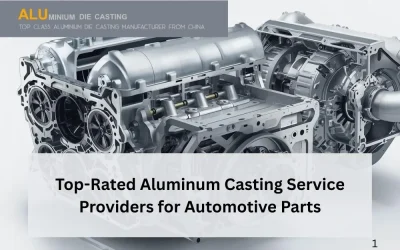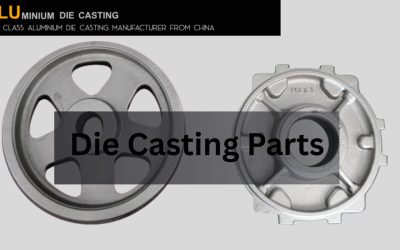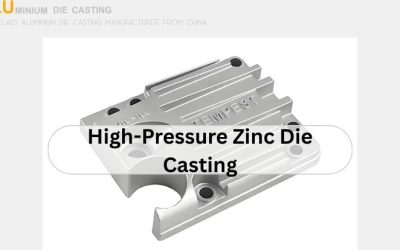A380 Aluminum Alloy Fundamentals for Beginners
A380 aluminum alloy is widely used in die casting processes. Its excellent fluidity allows for the production of complicated designs and thin-walled components. Due to its fluidity, the A380 aluminum is perfect for complex die casting applications requiring precise details. Furthermore, the A380 die casting aluminum offers an excellent combination of mechanical qualities, including yield, tensile strength, and elongation, making it perfect for parts that must tolerate deformation and stress.
Key Takeaways:
- A380: Die-cast aluminum alloy with high fluidity for complex parts.
- Pros: Excellent castability, good strength, tight pressure, and dimensional stability.
- Uses: Engine parts, electronics housing, power tools (moderate stress).
- Cons: Lower corrosion resistance and rougher surface finish are impossible for super strong parts.
- Choose: Consider limitations; compare alloys for specific needs.
Aluminum is the major component of the A380. However, it is not pure. A380 aluminum alloys with other elements to attain its unique qualities. One necessary element that significantly enhances the fluidity of the alloy is silicon (Si). The higher the silicon content, the greater the casting properties. Higher silicon concentration, however, can reduce the alloy’s mechanical strength. A380’s overall properties are further affected by the presence of other elements, like zinc (Zn).
What is aluminum a380 alloy?
In die casting, aluminum A380 alloy helps make complex parts with high precision. It is primarily aluminum, with silicon (Si) for improved fluidity during casting. Other elements like copper (Cu) contribute to strength and other properties.
Aluminum A380 Alloy Standards
ASTM International (ASTM): The ASTM B179 standard specification covers a380 aluminum alloy used in die casting. This standard identifies the chemical composition, mechanical properties, and other requirements for A380 aluminum die casting applications.
Aluminum Association (AA): According to the Aluminum Association, AA380.0-F identifies A380 in the US. That name has the same meaning as ASTM B179.
International Organization for Standardization (ISO): ISO designation EN1706: AlSi9Cu3(Fe) may also mean A380 aluminum alloy in Europe. This standard uses a slightly different notation to state the chemical composition of the alloy (AlSi9Cu3 means Aluminum 9% Silicon Copper 3% Iron).
Society of Automotive Engineers (SAE): SAE also provides a nomenclature for aluminum alloys. Within the automotive industry, “SAE 380” refers specifically to A380 sometimes.
Importance of Aluminum A380 Alloy Standards
The essence of Aluminum A380 alloy standards concerns the necessity of having the suitable material for your particular use and meeting any such industry requirements. Here is why standards matter:
Consistent Composition and Properties: Standards determine the actual chemical composition of A380 die casting aluminum and its mechanical properties, such as tensile strength and elongation, which means you get a material with predictable performance. Deflection from this standard may lead to unexpected results in the final product.
Quality Control: Standards often provide guidelines on quality control procedures that manufacturers must adhere to during the production process; as a result, these ensure that what you have been given meets the specific demands of the individual concerned.
Traceability: Maintaining traceability within certain establishments that require strict quality controls is vital.
Industry Acceptance: Specific industries like automotive or aerospace have material selection criteria. These guidelines often refer to recognized standards on A380 aluminum alloy to ensure compatibility and performance within their applications.
Avoiding Issues: There could be several problems arising from using unsuitable grades of A380 aluminum alloy:
Performance Issues: The end product may not have expected strengths, resistance against corrosion, or similar attributes.
Safety Concerns: In critical applications, wrong A380 aluminum alloy selections may create safety risks due to possible failures.
Production Delays: Failure of the material to meet specifications will cause delays and rework costs.
A380 Aluminum Alloy Ingot
A380 aluminum ingot is a cast form of the A380 aluminum alloy. These ingots are the raw material used in die casting. Depending on the foundry or manufacturer’s specific needs, they come in various sizes and shapes. Generally, they are large enough to melt down in casting processes.
Properties of Aluminum Alloy A380
The success of the A380 depends on its balanced qualities. Now, explore these properties in more detail:
Alloy composition of A380 Aluminum
A380 die casting aluminum alloy Mechanical Properties
The A380 die casting aluminum alloy has high yield strength, tensile strength, and elongation. Tensile strength is the maximum stress a material can endure before breaking into pieces. Yield strength is the stress level that will cause material deformation. Elongation is how much deformation a material can take before complete failure occurs. The A380 differs in some way; it can undergo certain stress levels and change its shape without breaking down. This brings us to silicon content, which helps stabilize things and reduces mechanical properties.
Thermal Properties of A380 die casting aluminum
The A380 aluminum die casting alloy has relatively good thermal conductivity compared to other options. Unsurprisingly, this means it transmits heat well, which is needed in applications where a heat sink is an essential factor. This property can be useful in parts such as the engine, which is exposed to intense heat during its functioning.
Other Important Properties
A380 aluminum alloy has also other valuable properties that should be needed for die casting processes. These include:
- Pressure tightening
- Dimensional stability
- Resistance to crack at high temperatures.
Pressure tightness proves the cast part can retain liquids or gases and is safe from rupturing. Dimensional stability reduces the chances of warping or shrinkage during casting, ensuring that the manufactured parts are accurate. Resisting hot cracking ensures that cracks do not form in the cast component as it cools. These properties are significant enough to guarantee the production of high-quality parts through die-casting.
A380 Aluminum Alloy Mechanical Properties Table
A380 Aluminum alloy Physical Properties Table
Applications of Aluminum Alloy A380
There are many reasons why the A380 is qualified for various uses due to its properties. Its great casting and mechanical properties enable it to be used in many industries.
Automotive Industry:
Engine components: Transmission housings, engine brackets and water pump housings
Structural parts: Suspension components (depending on specific requirements), frames
Electronics Industry:
Electronic housings: Computer housing, laptop housing, TV housing and other electronic devices
Heatsinks: It helps to dissipate heat produced by electrical appliances.
Power Tools and Machinery:
Power tool housings: Housing for power tools like drills, saws, sanders, etc.
Machinery components: Housings in machinery like covers and non-critical structural parts.
Furniture and Construction:
Furniture components: Tables frames, furniture frames etc.
Some factors must also be considered when selecting an alloy. Finally, let me describe the characteristics of the A380 compared to other available options.
A380 die casting aluminum vs. Other Casting Alloys
A380 Aluminum vs. 6061 Aluminum: A Comparison
Both A380 and 6061 aluminum alloy are popular aluminum alloys in different industries. The following is a summary of their main features that will help you make the right choice for your application:
Process:
-
A380 aluminum alloy: Primarily used in die casting.
-
6061 aluminum: Primarily used in wrought processes like extrusion, rolling, and forging.
Properties:
A380 die casting aluminum alloy is not the only prominent alloy in the die casting industry. ADC10 aluminum alloy is another example of an aluminum die casting alloy in the casting market. The nature of operation of both the A380 and ADC10 aluminum alloy is similar. Both can be used in many similar tasks. However, there are many areas where A380 is superior to B747 in terms of castability and pressure tightness. Therefore, the selection between the A380 and other alloys depends on the unique requirements of the distinct application.
Choosing the Right Alloy
Choosing the proper alloy is critical since various applications require different materials that can withstand specific conditions. For example, mechanical properties would have more focus if strength is high. On the other hand, where excellent castability and pressure tightness are essential, the A380 die casting aluminum can be the best option.
Cost of A380 and Other Aluminum Alloys
Widely Available Alloy: A380 aluminum alloy is a well-known aluminum alloy. Anyone can purchase this material from the market or order it from any producer or distributor globally. This means manufacturers that use this flexible material will always find it easy to source since it is available in large quantities.
Price Consideration: The cost of aluminum alloy A380 can vary based on several factors. A change in the supply and demand of aluminum can cause a change in the price of the material used in making the alloy. Moreover, the number ordered can also impact the cost, with large orders often receiving a more reasonable price per unit.
Price of 10 Common Aluminum Alloys Including A380
Conclusion
The Aluminum Alloy A380 has made itself a reliable and flexible material in the die-casting industry. To make high-performance parts, a professional die caster is mandatory. Alu Die Casting has a range of aluminum alloys for making high-precision die-casting parts.
FAQs
In this section, we’ll answer the most frequently asked questions related to Aluminum alloy A380:
Q: What are the commonly used casting methods for aluminum alloy A380?
Ans: A380 and Die Casting: The A380 is mainly used for die casting processes. This high-pressure casting method enables the creation of complex shapes with high detail quality. Another reason for choosing the A380 is its remarkable and versatile fluidity of die casting.
Q: Can you recycle A380 die casting aluminum?
Ans: Recyclable Metal: A380 aluminum alloy, like most aluminum alloys, is mainly used in nature and can be easily recycled. This has environmental factors and cost advantages, as recycled aluminum uses even less energy than virgin aluminum.
Q: What are the Aluminum Alloy A380’s Limitations?
Ans: Corrosion Resistance: We all know that the A380 has remarkable properties, but it is also important to consider its limitations. The A380 alloy has a lower corrosion potential than other aluminum alloys. Other types of alloys might be more suitable for applications that demand high corrosion performance.
Surface Finishing: Another important consideration is that of Surface finishing. A380 aluminum alloy could need extra surface treatment for applications that require a smooth surface finish.
High-Strength Applications: As we already discussed, the A380 aluminum alloy possesses excellent mechanical properties; however, some specific cases require greater strength. In such cases, it is advisable to consider alloys specially developed for strength.









0 Comments